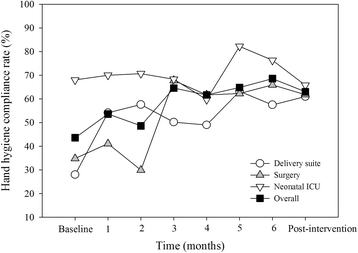An educational intervention to improve hand hygiene compliance in Vietnam
- PMID: 29514595
- PMCID: PMC5840927
- DOI: 10.1186/s12879-018-3029-5
An educational intervention to improve hand hygiene compliance in Vietnam
Abstract
Background: Hand hygiene compliance is the basis of infection control programs. In developing countries models to improve hand hygiene compliance to reduce healthcare acquired infections are required. The aim of this study was to determine hand hygiene compliance following an educational program in an obstetric and gynecological hospital in Vietnam.
Methods: Health care workers from neonatal intensive care, delivery suite and a surgical ward from Hung Vuong Hospital, Ho Chi Minh City, Vietnam undertook a 4-h educational program targeting hand hygiene. Compliance was monitored monthly for six months following the intervention. Hand hygiene knowledge was assessed at baseline and after six months of the study.
Results: There were 7124 opportunities over 370 hand hygiene recording sessions with 1531 opportunities at baseline and 1620 at 6 months following the intervention. Hand hygiene compliance increased significantly from baseline across all sites (43.6% [95% Confidence interval CI: 41.1-46.1] to 63% [95% CI: 60.6-65.3]; p < 0.0001). Health care worker hand hygiene compliance increased significantly after intervention (p < 0.0001). There were significant improvements in knowledge scores from baseline to 2 months post educational intervention with mean difference standard deviations (SD): 1.5 (2.5); p < 0.001).
Conclusions: A simple educational model was implemented in a Vietnamese hospital that revealed good hand hygiene compliance for an extended period of time. Hand hygiene knowledge increased during the intervention. This hand hygiene model could be used in developing countries were resources are limited.
Keywords: Compliance; Developing country; Education; Hand hygiene; Infection.
Conflict of interest statement
Ethics approval and consent to participate
Ethical approval was granted by the Institutional Ethical Review Committee of Hung Vuong hospital in July 2014 (158 QD-BVHV). All participants provided written, informed consent prior to commencing the study.
Consent for publication
Not applicable
Competing interests
The authors declare that they have no competing interests.
Publisher’s Note
Springer Nature remains neutral with regard to jurisdictional claims in published maps and institutional affiliations.
Figures

Similar articles
-
Sustained effects of a multimodal campaign aiming at hand hygiene improvement on compliance and healthcare-associated infections in a large gynaecology/obstetrics tertiary-care centre in Vietnam.Antimicrob Resist Infect Control. 2020 Apr 10;9(1):51. doi: 10.1186/s13756-020-00712-x. Antimicrob Resist Infect Control. 2020. PMID: 32276646 Free PMC article.
-
Cost-effectiveness of a hand hygiene program on health care-associated infections in intensive care patients at a tertiary care hospital in Vietnam.Am J Infect Control. 2015 Dec 1;43(12):e93-9. doi: 10.1016/j.ajic.2015.08.006. Epub 2015 Oct 1. Am J Infect Control. 2015. PMID: 26432185
-
Global implementation of WHO's multimodal strategy for improvement of hand hygiene: a quasi-experimental study.Lancet Infect Dis. 2013 Oct;13(10):843-51. doi: 10.1016/S1473-3099(13)70163-4. Epub 2013 Aug 23. Lancet Infect Dis. 2013. PMID: 23972825
-
Three years of national hand hygiene campaign in Germany: what are the key conclusions for clinical practice?J Hosp Infect. 2013 Feb;83 Suppl 1:S11-6. doi: 10.1016/S0195-6701(13)60004-3. J Hosp Infect. 2013. PMID: 23453170 Review.
-
New technologies to monitor healthcare worker hand hygiene.Clin Microbiol Infect. 2014 Jan;20(1):29-33. doi: 10.1111/1469-0691.12458. Clin Microbiol Infect. 2014. PMID: 24245809 Review.
Cited by
-
A multifaceted hand hygiene improvement program on the intensive care units of the National Referral Hospital of Indonesia in Jakarta.Antimicrob Resist Infect Control. 2019 Jun 3;8:93. doi: 10.1186/s13756-019-0540-4. eCollection 2019. Antimicrob Resist Infect Control. 2019. PMID: 31171964 Free PMC article. Clinical Trial.
-
Effectiveness of a hand hygiene training intervention in improving knowledge and compliance rate among healthcare workers in a respiratory disease hospital.Heliyon. 2024 Mar 4;10(5):e27286. doi: 10.1016/j.heliyon.2024.e27286. eCollection 2024 Mar 15. Heliyon. 2024. PMID: 38486731 Free PMC article.
-
Multimodal strategies to hand hygiene in Ghanaian hospitals: a cross-sectional study in the Eastern Region of Ghana.BMJ Public Health. 2024 Feb 5;2(1):e000606. doi: 10.1136/bmjph-2023-000606. eCollection 2024 Jun. BMJ Public Health. 2024. PMID: 40018169 Free PMC article.
-
Bioengineering Innovations in Global Dental Infection Control: Applications and Adaptations in Clinical Settings.Int Dent J. 2025 Jun;75(3):2222-2238. doi: 10.1016/j.identj.2024.12.011. Epub 2024 Dec 30. Int Dent J. 2025. PMID: 39741063 Free PMC article.
-
Quality Improvement Project to Improve Hand Hygiene Compliance in a Level III Neonatal Intensive Care Unit.Children (Basel). 2023 Aug 30;10(9):1484. doi: 10.3390/children10091484. Children (Basel). 2023. PMID: 37761445 Free PMC article.
References
-
- World Health Organization. Report on the burden of endemic health care-associated infection worldwide. Geneva: World Health Organization Press; 2011. Available http://apps.who.int/iris/bitstream/10665/80135/1/9789241501507_eng.pdf
-
- JM B, Pittet D. Society for Healthcare Epidemiology of America/Association for Professionals in infection control/Infectious Diseases Society of America; morbidity mortality weekly report. 2002. Healthcare infection control practices advisory committee, HICPAC/SHEA/APIC/IDSA hand hygiene task force: guideline for hand hygiene in health-care settings: recommendations of the healthcare infection control practices advisory committee and the HICPAC/SHEA/APIC/IDSA hand hygiene task force; pp. 51–45. - PubMed
-
- World Health Organization. WHO guidelines on hand hygiene in health care. Geneva; 2009. Available http://apps.who.int/iris/bitstream/10665/44102/1/9789241597906_eng.pdf. Accessed 10 Mar 2017.
-
- Salmon S, Nguyen V, McLaws M, Pittet D, Kilpatrick C, Le T, Truong A. Hand hygiene campaigns in a low resource context: a Vietnam perspective. BioMed Central Proceedings. 2011;5(Suppl 6):O22.
Publication types
MeSH terms
LinkOut - more resources
Full Text Sources
Other Literature Sources
Medical

